
Fundamentals of Carbonate Sequence Stratigraphy
Charles Kerans
Scott W. Tinker
Bureau of Economic Geology
| Design Objectives |
| Glossary |
| Credits |
| Back |
| Top |
| Exit |
 |
 |
 |
| Reservoir Geology Carbonates: Module 3 |
| The basics of seismic stratigraphy |
Modern
sequence stratigraphy is a direct outgrowth of the concept of
unconformity bound stratigraphic units as proposed by Sloss (1964).
In simplest terms, Sloss's (1964) sequence stratigraphy was a
tool to identify major unconformity-bound packages (e.g., Sauk,
Kaskaskia) for the purpose of correlation across large areas of
the craton. We now call these 2nd order sequences. The second major evolutionary step in the conceptual evolution to modern sequence stratigraphy was seismic stratigraphy. AAPG Memoir 26 (Payton et al. 1977) captures, in a series of manuscripts by Exxon geologists, a methodology for identifying Slossian type unconformity-bound sequences using reflection seismic data. The emphasis of this methodology was the use of seismic geometry and termination styles to delineate unconformity-bound seismic sequences, derivation of eustatic curves using coastal onlap (Vail et al. 1977a), and global sequence correlation based on biostratigraphic control (Vail et al. 1977b). Another key aspect of this research (Vail et al. 1977c), which was also echoed by Brown and Fisher (1977) among others, was the chronostratigraphic significance of seismic reflectors. The observation that a single shelf-to-basin reflector mimicked a depositional timeline opened the door for sedimentologic analysis of the internal make-up of seismic sequences. This seismic chronostratigraphy led to the third key development, which was concept of sequence stratigraphy. The transition from seismic stratigraphy to sequence stratigraphy represents a major conceptual jump. Focus shifted from global mapping of unconformity-bound packages to the interpretation of the internal reflector patterns of stratigraphic sequences, which came to be viewed as genetically-significant depositional sequences. Eighties-style sequence stratigraphy (Vail 1987; Posementier and Vail 1988; Van Wagoner et al. 1988) focused on viewing sequences as unconformity-bound units that are also genetic depositional cycles associated with global sea-level change. In sequence stratigraphic terms, it was proposed that depositional sequences contain a predictable suite of systems tracts and lithofacies tracts tied to a sinusoidal eustatic curve, and can be correlated worldwide. This global correlation model can also be used locally to predict reservoir, source, and seal lithofacies within the idealized genetic packages by developing a standard suite of lithofacies tracts associated with lowstand, transgressive, and highstand systems tracts. For geologists interested in constructing accurate stratigraphic frameworks for reservoir characterization, the analysis of the internal anatomy of sequences is more important than the global correlation methodologies. One significant evolutionary step occurred after the introduction of sequence stratigraphy, which came about through the application of sequence concepts to reservoir characterization and to outcrop investigations. Using wireline logs and cores from the subsurface combined with outcrop cross sections, it became apparent that an additional level of stratigraphic sequences could be resolved within seismically-definable depositional sequences. The development of this outcrop-core-log based sequence stratigraphy has been referred to as high-resolution, or high-frequency sequence stratigraphy, and represents the critical scale at which reservoir-scale sequence descriptions should be carried out. High-frequency sequence stratigraphy recognizes that when the more detailed subsurface data from wireline logs are examined within a seismically-defined depositional sequence, a number of unconformity bound sequences can be recognized. These high-frequency sequences and their component cycles represent the scale of observation critical to reservoir model construction. |
 |
|
Figure
1.
|
Seismic
stratigraphic interpretation results from the recognition of various
lapout signatures recorded by seismic amplitudes (Fig. 1). The
boundaries represented by the seismic lapout patterns were interpreted
to be unconformities or correlative conformities and called sequence
boundaries. A generic shelf-to-basin profile for depositional
sequences in clastic systems was originally published by EXXON
(Fig. 2). The basic components of a depositional sequence include
the Lowstand Systems Tract (LST) and its depositional elements;
the Transgressive Systems Tract (TST), deposited during relative
sea level rise; and the Highstand Systems Tract (HST) deposited
during relative sea level fall and separated from the TST by the
Maximum Flooding Surface. These sequence components and terms
serve to provide a common language to many workers in subsurface
settings of all scales. |
The
Classic EXXON Model |
||||
|
| Most
of the formative background of sequence stratigraphic concepts
are rooted in siliciclastic stratigraphy, begging the question
as to how applicable these concepts are to carbonate strata. The
degree of transference has been a topic of active debate since
these concepts were introduced (Schlager 1992) and differences
and similarities between the siliciclastic EXXON model and some
ideal carbonate model are still being evaluated (Sarg et al. 1996;
Kerans and Tinker, 1997). One conclusion that meets with general
agreement is that the 1-for-1 match between siliciclastic and
carbonate models, changing only facies tract terms (Vail 1987;
Sarg 1988) is not a good solution. The fundamental differences
between these two sedimentary systems are the autochthonous origin
of carbonate sediments and their susceptibility to early diagenesis
including early lithification. These two factors significantly
change the carbonate model. Lowstand systems tracts in particular
are not well represented during base-level fall and exposure of
the shelf, when carbonate sediments become lithified instead of
reworked downslope, making lowstand systems tracts a minor segment
of the sequence model. Composition of lowstand carbonates and
timing of sediment delivery should also be different, containing
a higher proportion of lithoclastic grains. Autochthonous sediment supply in carbonates also implies differences from the siliciclastic model. During a transgression, rather than trapping the sediment supply well updip as is commonly depicted for clastic models, carbonate sediments may respond to the base-level rise by producing sediment at a high rate (keep-up) forming local buildup facies and thick cycles (Tinker, 1998). Differences and similarities between siliciclastic and carbonate models are still being documented and evaluated. |
| |